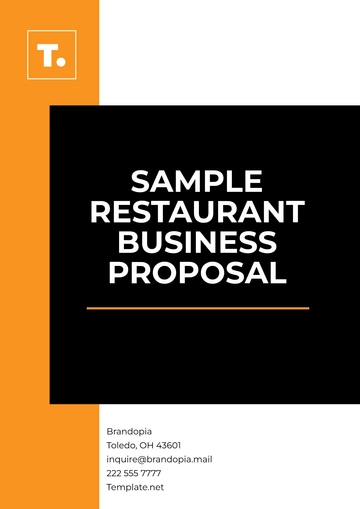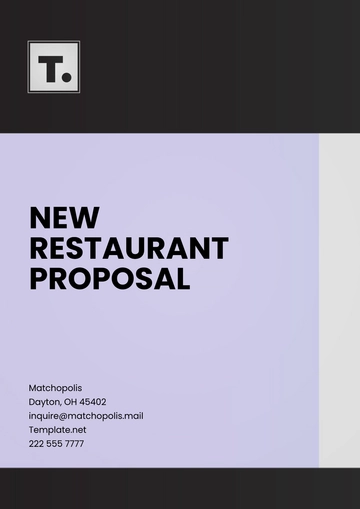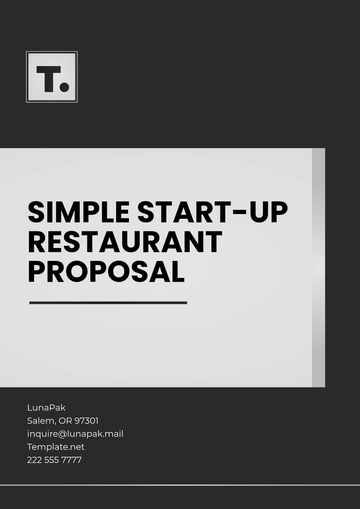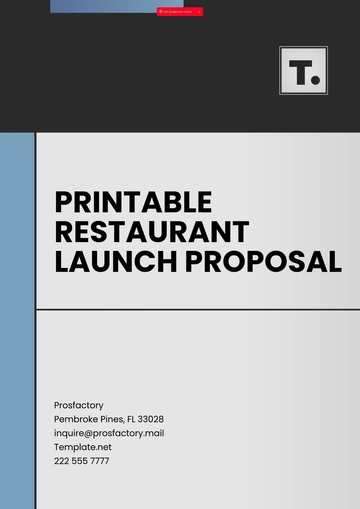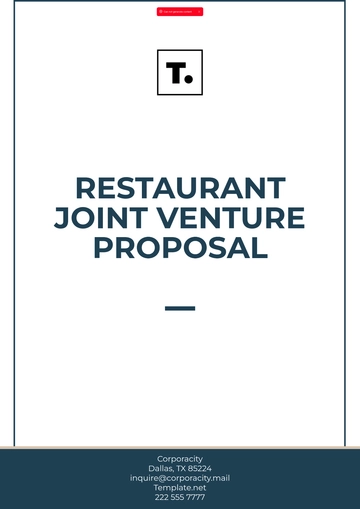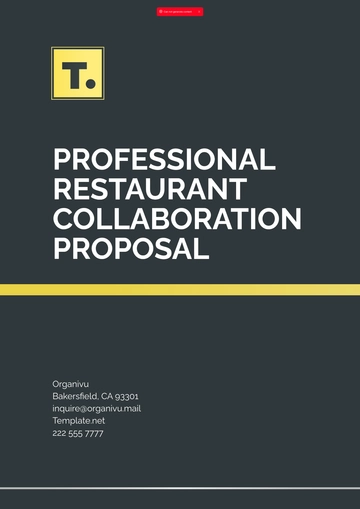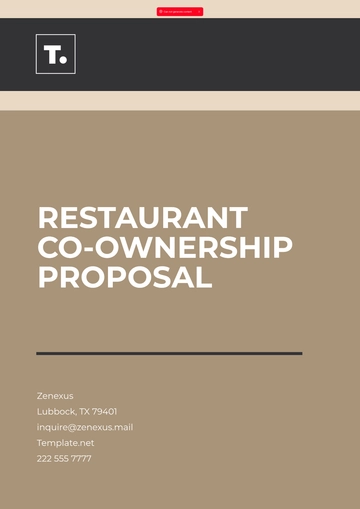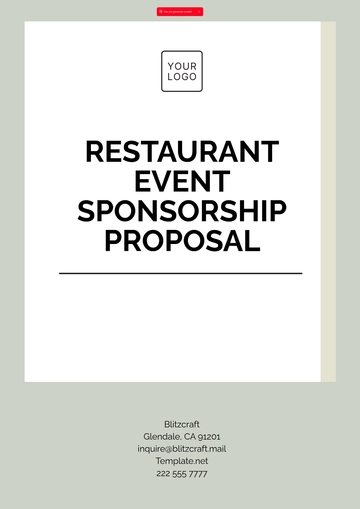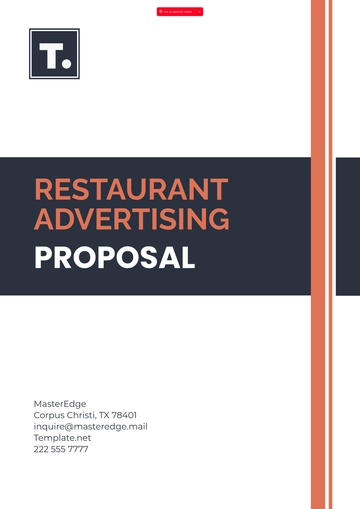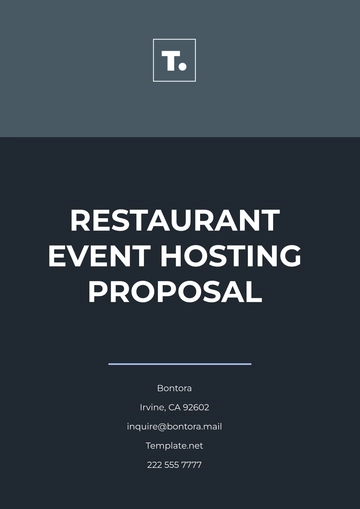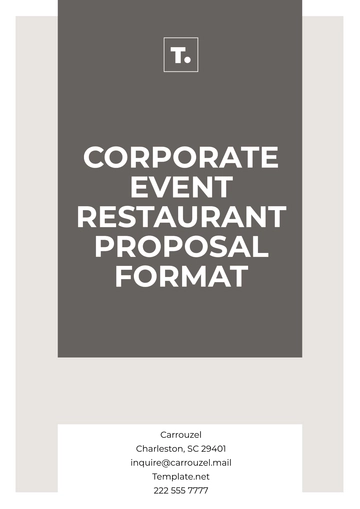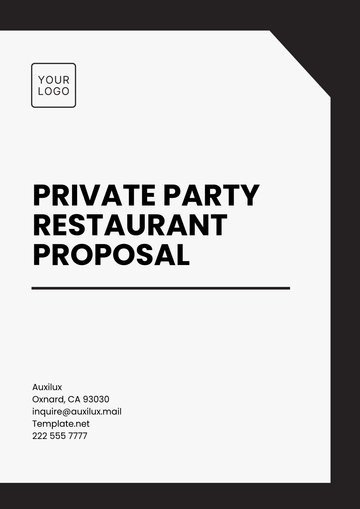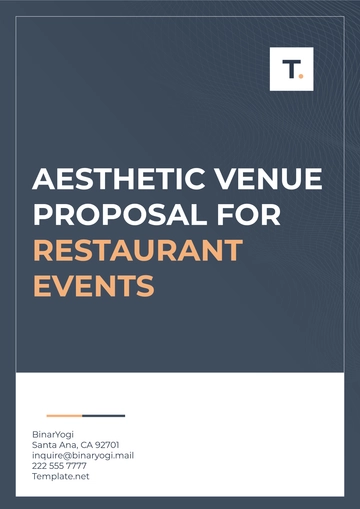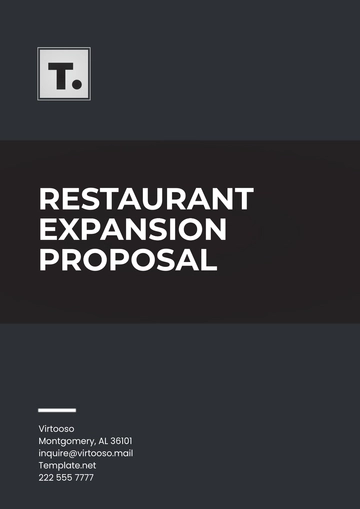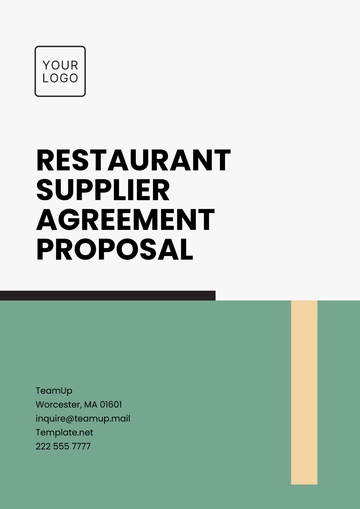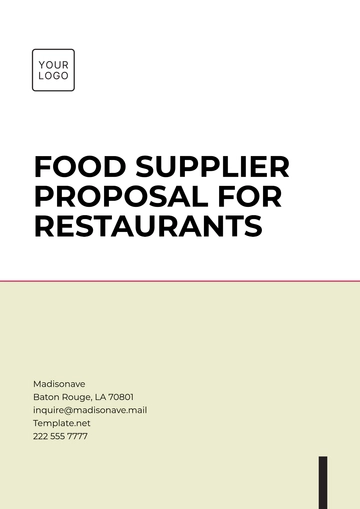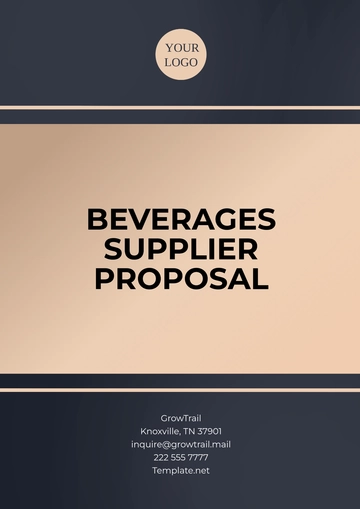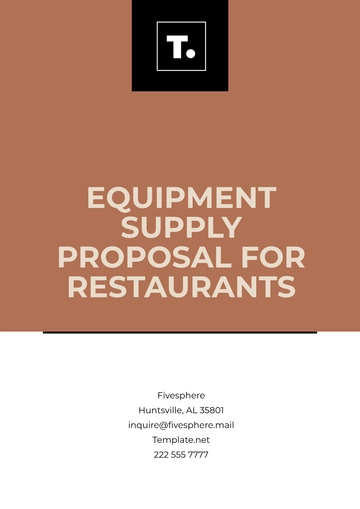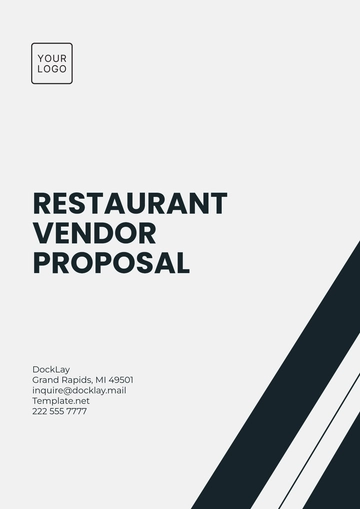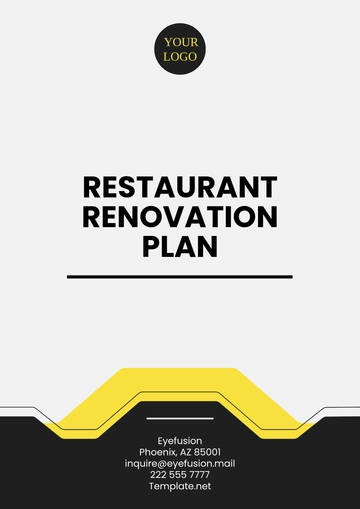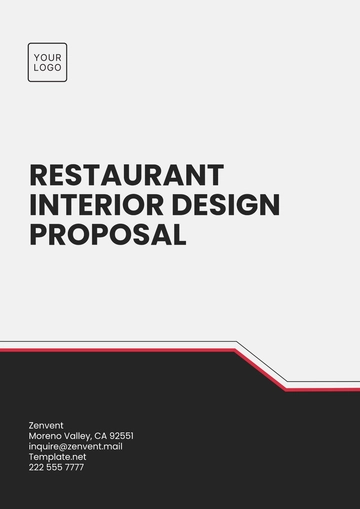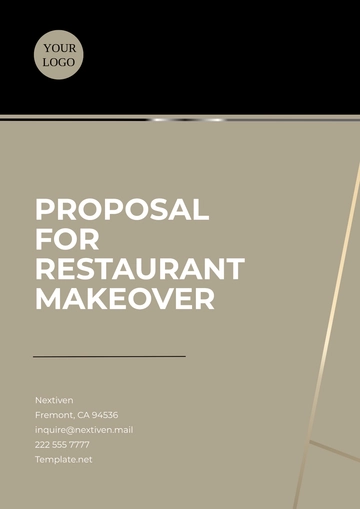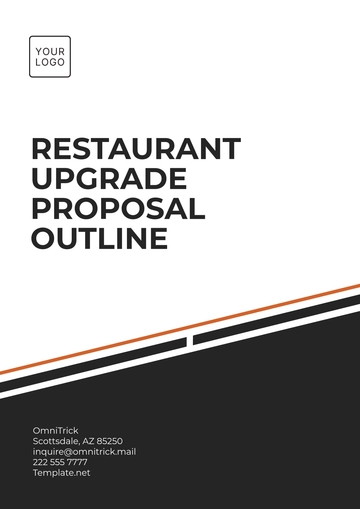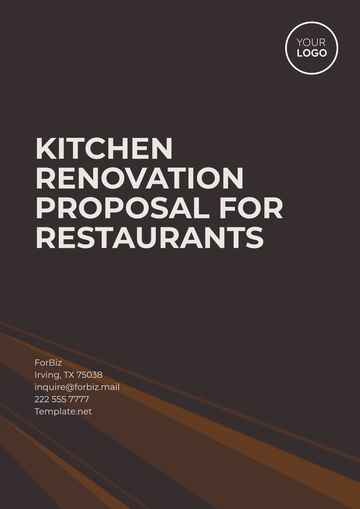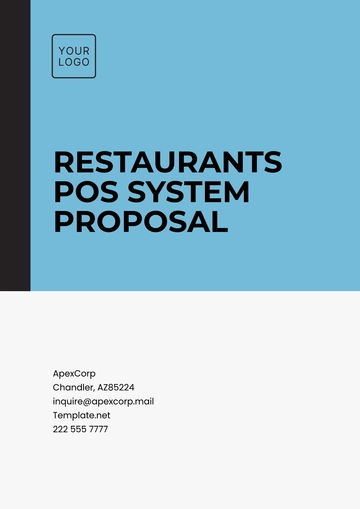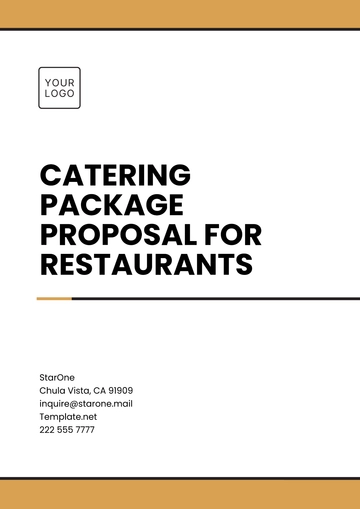Free Restaurant Research Proposal
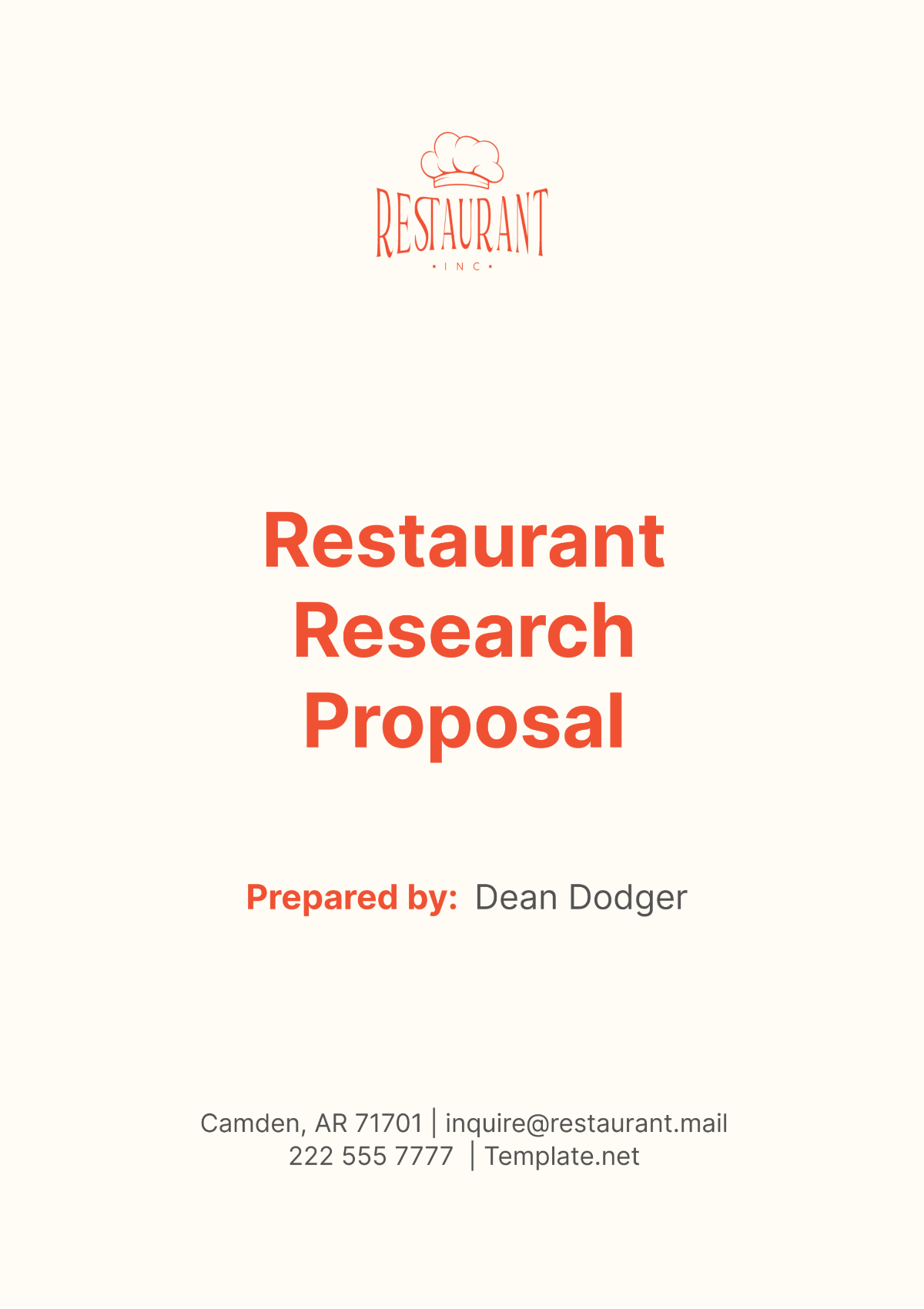
I. Introduction
[Your Company Name], a renowned restaurant in [location], is dedicated to providing exceptional dining experiences to our customers. In line with our commitment to continuous improvement and innovation, we are proposing a research project to explore consumer preferences and trends in the restaurant industry. This research aims to enhance our understanding of our target market, optimize our menu offerings, and refine our marketing strategies to better meet the needs and preferences of our customers.
II. Background and Literature Review
The restaurant industry is highly competitive, with rapidly changing consumer preferences and dining trends. To stay ahead in this dynamic environment, it is essential for restaurants to stay informed about market trends, consumer behavior, and emerging opportunities. Several studies have investigated various aspects of the restaurant business, including menu design, pricing strategies, customer satisfaction, and the impact of technology on dining experiences. However, there is still a need for research specifically tailored to the unique characteristics of [Your Company Name] and its target market.
III. Research Objectives
The primary objectives of this research are as follows:
To identify the factors influencing dining preferences among our target demographic.
To assess the effectiveness of our current menu offerings and identify opportunities for improvement.
To understand the impact of external factors such as economic conditions and cultural trends on consumer behavior.
To explore potential strategies for enhancing customer engagement and loyalty.
To provide actionable insights that will inform decision-making and drive business growth.
IV. Methodology
The research will employ a mixed-methods approach, combining qualitative and quantitative techniques to gather comprehensive data. The methodology will include:
Surveys: Online and in-person surveys will be distributed to our customer base to collect demographic information, dining preferences, and feedback. The surveys will be designed to capture insights into factors influencing dining choices, satisfaction levels with current offerings, and suggestions for improvement. The online surveys will be distributed through our website and social media channels, while in-person surveys will be conducted at the restaurant premises to ensure a diverse sample.
Focus Groups: Focus group discussions will be organized with selected participants representing various segments of our target demographic. These discussions will provide a platform for in-depth exploration of specific topics related to dining preferences, perceptions of our brand, and suggestions for menu enhancements. The focus groups will be facilitated by experienced moderators and will involve structured discussions aimed at uncovering nuanced insights and perspectives.
Menu Analysis: Sales data and customer feedback will be analyzed to evaluate the popularity and profitability of existing menu items. This analysis will involve examining sales trends, customer ratings, and comments to identify top-performing dishes as well as areas for improvement. Additionally, menu pricing will be assessed to ensure competitive positioning and profitability. The findings from the menu analysis will inform decisions regarding menu optimization, introduction of new items, and pricing adjustments.
Market Research: Industry reports, market trends, and competitor analysis will be reviewed to gain a broader perspective on the restaurant landscape. This secondary research will provide valuable context for understanding macroeconomic factors, emerging trends, and competitive dynamics shaping the industry. By staying abreast of market developments and benchmarking against competitors, we can identify strategic opportunities and potential threats, guiding our decision-making process.
The combination of these research methods will provide a comprehensive understanding of consumer preferences, market trends, and competitive dynamics, enabling us to make informed decisions to enhance the dining experience and drive business growth at [Your Company Name].
V. Timeline
The timeline below outlines the key phases of the research project, delineating the progression from planning and data collection to analysis, reporting, and review. Each phase is allocated a specific duration to ensure timely completion and adherence to project milestones.
Phase | Duration |
|---|---|
Research Planning | 1 month |
Data Collection | 2 months |
Data Analysis | 1 month |
Report Writing | 1 month |
Presentation & Review | 2 weeks |
Research Planning: Allocate 1 month for thorough planning, including defining research objectives, designing survey instruments, and recruiting participants for focus groups.
Data Collection: Allocate 2 months to gather data through surveys, focus groups, and menu analysis, ensuring comprehensive coverage of customer preferences and market trends.
Data Analysis: Dedicate 1 month to analyze collected data using appropriate statistical and qualitative techniques, extracting meaningful insights to inform decision-making.
Report Writing: Allocate 1 month for compiling research findings into a comprehensive report, including an executive summary, methodology, results, and recommendations.
Presentation & Review: Allocate 2 weeks for presenting the research findings to stakeholders and conducting a thorough review to validate findings and refine recommendations.
VI. Budget
The following table provides an estimated breakdown of the budget required to execute the research project effectively. These figures encompass expenses related to survey administration, focus group facilitation, data analysis software, and personnel costs.
Expense Item | Estimated Cost (USD) |
|---|---|
Survey Administration | $5,000 |
Focus Group Facilitation | $3,500 |
Data Analysis Software | $1,200 |
Personnel Costs | $8,000 |
Miscellaneous Expenses | $1,300 |
Total | $19,000 |
Budget Allocation: The total budget allocated for the research project amounts to $19,000, encompassing various essential expenses.
Survey Administration: A significant portion of the budget, $5,000, is dedicated to survey administration, highlighting the importance of gathering comprehensive data from our diverse customer base.
Focus Group Facilitation: $3,500 is allocated for focus group facilitation, ensuring in-depth discussions and insights from selected participants representing diverse demographics.
Data Analysis Software: An allocation of $1,200 is made for data analysis software, essential for processing and interpreting the collected data effectively.
Personnel Costs: $8,000 is budgeted for personnel costs, including salaries for research team members involved in data collection, analysis, and reporting.
Miscellaneous Expenses: A provision of $1,300 is made for miscellaneous expenses, covering unforeseen costs and additional resources required during the research process.
VII. Potential Outcomes and Implications
Menu Optimization: Insights gained from the research can facilitate menu optimization by identifying top-performing dishes, eliminating underperforming items, and introducing new offerings tailored to customer preferences. This can lead to increased customer satisfaction, higher sales, and improved profitability.
Targeted Marketing Strategies: Understanding consumer preferences and behavior enables the development of targeted marketing strategies, including personalized promotions, social media campaigns, and loyalty programs. By effectively reaching and engaging our target audience, we can enhance brand awareness, attract new customers, and foster long-term relationships.
Operational Enhancements: The research findings can inform operational enhancements to streamline processes, improve efficiency, and enhance the overall dining experience. This may involve optimizing staffing levels, refining service procedures, or implementing technology solutions to expedite order processing and delivery.
Competitive Advantage: By staying abreast of market trends and consumer preferences, [Your Company Name] can maintain a competitive advantage in the restaurant industry. Leveraging insights from the research, we can differentiate our offerings, capitalize on emerging opportunities, and anticipate and respond to competitive threats effectively.
Customer Engagement and Loyalty: Tailoring our offerings and services to meet the needs and preferences of our customers fosters stronger engagement and loyalty. By delivering memorable dining experiences that resonate with our target audience, we can build a loyal customer base that continues to patronize [Your Company Name] and recommends us to others.
Strategic Decision-Making: The research findings serve as valuable inputs for strategic decision-making, guiding investments, resource allocation, and long-term planning initiatives. Whether expanding to new locations, diversifying the menu, or enhancing the dining environment, data-driven insights ensure informed and strategic decisions that support business growth and sustainability.
Community Impact: [Your Company Name] strives to make a positive impact on the community it serves. By aligning our offerings and initiatives with community values and preferences, we can contribute to the local economy, support local suppliers, and participate in charitable activities that resonate with our customers.
Continuous Improvement: Finally, the research process itself promotes a culture of continuous improvement within [Your Company Name]. By soliciting feedback, analyzing data, and adapting strategies based on insights gained, we demonstrate our commitment to excellence and our dedication to meeting and exceeding customer expectations.
VIII. Conclusion
In conclusion, this research proposal outlines a comprehensive plan to investigate consumer preferences and trends in the restaurant industry, with the ultimate goal of driving business growth and enhancing customer satisfaction at [Your Company Name]. We are confident that the insights gained from this research will inform strategic decision-making and contribute to the continued success of our restaurant.
- 100% Customizable, free editor
- Access 1 Million+ Templates, photo’s & graphics
- Download or share as a template
- Click and replace photos, graphics, text, backgrounds
- Resize, crop, AI write & more
- Access advanced editor
Propose innovative research with Template.net's Restaurant Research Proposal Template. Editable in our AI Editor Tool, this customizable template ensures clarity and professionalism in your proposals. Crafted for impact and accuracy, it streamlines your research planning process, covering objectives, methodologies, and timelines. Elevate your restaurant's insights with this essential resource from Template.net.
You may also like
- Business Proposal
- Research Proposal
- Proposal Request
- Project Proposal
- Grant Proposal
- Photography Proposal
- Job Proposal
- Budget Proposal
- Marketing Proposal
- Branding Proposal
- Advertising Proposal
- Sales Proposal
- Startup Proposal
- Event Proposal
- Creative Proposal
- Restaurant Proposal
- Blank Proposal
- One Page Proposal
- Proposal Report
- IT Proposal
- Non Profit Proposal
- Training Proposal
- Construction Proposal
- School Proposal
- Cleaning Proposal
- Contract Proposal
- HR Proposal
- Travel Agency Proposal
- Small Business Proposal
- Investment Proposal
- Bid Proposal
- Retail Business Proposal
- Sponsorship Proposal
- Academic Proposal
- Partnership Proposal
- Work Proposal
- Agency Proposal
- University Proposal
- Accounting Proposal
- Real Estate Proposal
- Hotel Proposal
- Product Proposal
- Advertising Agency Proposal
- Development Proposal
- Loan Proposal
- Website Proposal
- Nursing Home Proposal
- Financial Proposal
- Salon Proposal
- Freelancer Proposal
- Funding Proposal
- Work from Home Proposal
- Company Proposal
- Consulting Proposal
- Educational Proposal
- Construction Bid Proposal
- Interior Design Proposal
- New Product Proposal
- Sports Proposal
- Corporate Proposal
- Food Proposal
- Property Proposal
- Maintenance Proposal
- Purchase Proposal
- Rental Proposal
- Recruitment Proposal
- Social Media Proposal
- Travel Proposal
- Trip Proposal
- Software Proposal
- Conference Proposal
- Graphic Design Proposal
- Law Firm Proposal
- Medical Proposal
- Music Proposal
- Pricing Proposal
- SEO Proposal
- Strategy Proposal
- Technical Proposal
- Coaching Proposal
- Ecommerce Proposal
- Fundraising Proposal
- Landscaping Proposal
- Charity Proposal
- Contractor Proposal
- Exhibition Proposal
- Art Proposal
- Mobile Proposal
- Equipment Proposal
- Student Proposal
- Engineering Proposal
- Business Proposal

